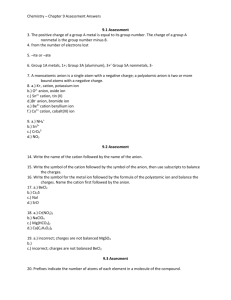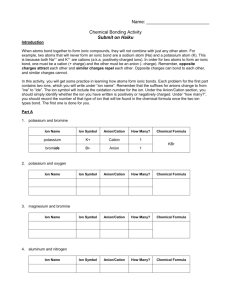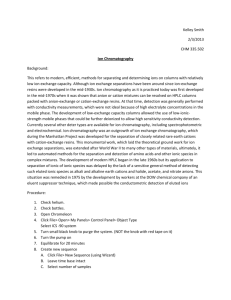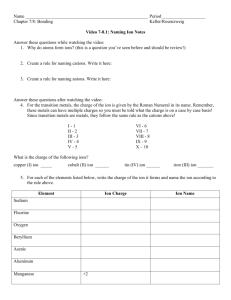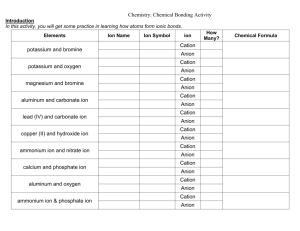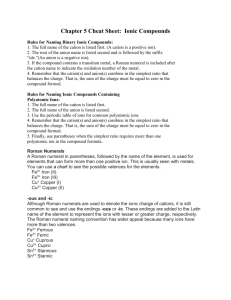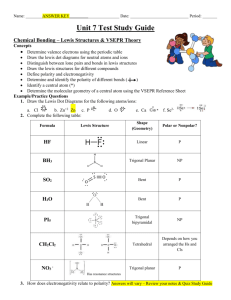Chemical Bonding Activity: Ionic Compounds
advertisement
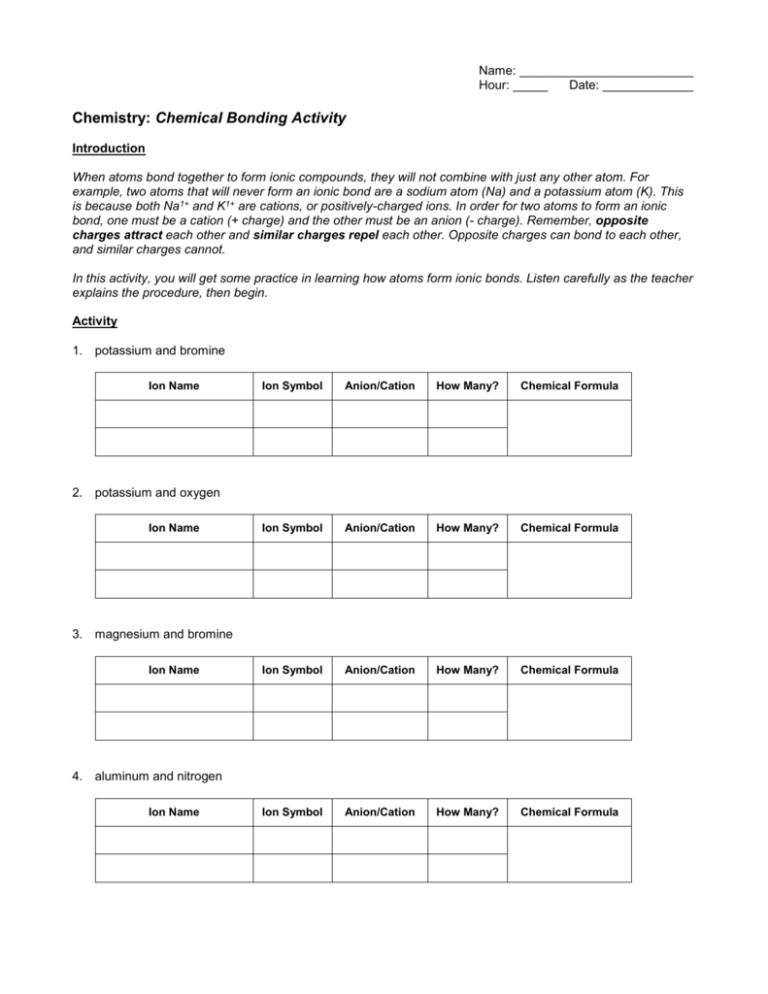
Name: _________________________ Hour: _____ Date: _____________ Chemistry: Chemical Bonding Activity Introduction When atoms bond together to form ionic compounds, they will not combine with just any other atom. For example, two atoms that will never form an ionic bond are a sodium atom (Na) and a potassium atom (K). This is because both Na1+ and K1+ are cations, or positively-charged ions. In order for two atoms to form an ionic bond, one must be a cation (+ charge) and the other must be an anion (- charge). Remember, opposite charges attract each other and similar charges repel each other. Opposite charges can bond to each other, and similar charges cannot. In this activity, you will get some practice in learning how atoms form ionic bonds. Listen carefully as the teacher explains the procedure, then begin. Activity 1. potassium and bromine Ion Name Ion Symbol Anion/Cation How Many? Chemical Formula Ion Symbol Anion/Cation How Many? Chemical Formula Ion Symbol Anion/Cation How Many? Chemical Formula Ion Symbol Anion/Cation How Many? Chemical Formula 2. potassium and oxygen Ion Name 3. magnesium and bromine Ion Name 4. aluminum and nitrogen Ion Name 5. lead (IV) and nitrogen Ion Name Ion Symbol Anion/Cation How Many? Chemical Formula Ion Symbol Anion/Cation How Many? Chemical Formula Ion Symbol Anion/Cation How Many? Chemical Formula Ion Symbol Anion/Cation How Many? Chemical Formula Ion Symbol Anion/Cation How Many? Chemical Formula Ion Symbol Anion/Cation How Many? Chemical Formula 6. copper (II) and hydroxide ion Ion Name 7. ammonium ion and nitrate ion Ion Name 8. calcium and phosphate ion Ion Name 9. ammonium ion and phosphate ion Ion Name 10. aluminum and oxygen Ion Name 11 and 12. Make two compounds of iron and oxygen. Ion Name Ion Symbol Anion/Cation How Many? Chemical Formula Ion Name Ion Symbol Anion/Cation How Many? Chemical Formula 13 and 14. Make two compounds of lead and sulfur. Ion Name Ion Symbol Anion/Cation How Many? Chemical Formula Ion Name Ion Symbol Anion/Cation How Many? Chemical Formula 15 and 16. Make two compounds of copper and oxygen. Ion Name Ion Symbol Anion/Cation How Many? Chemical Formula Ion Name Ion Symbol Anion/Cation How Many? Chemical Formula Use the pieces to make one molecule (technically, the term should be “formula unit,” since these are ionic compounds) of any five of the compounds and get your teacher’s initials. Chemical Formula of Compound 1. 2. 3. 4. 5. Teacher’s Initials Questions 1. What was the overall charge on all of the molecules (formula units) that you constructed? 2. Compare your pieces with the Periodic Table and answer these questions. a. Do nonmetals form anions or cations? b. Do metals form anions or cations? c. What is the charge for all of the elements in Group 1? d. What is the charge for all of the elements in Group 2? e. What is the charge for all of the elements in Group 17? f. Do cation pieces fit with other cation pieces? g. Do anion pieces fit with other anion pieces? 3. What type of elements (metals, metalloids, or nonmetals) form ionic bonds with metals? 4. What type of elements (metals, metalloids, or nonmetals) form ionic bonds with nonmetals? 5. Write the chemical formula that results when the following pairs of ions combine to form an ionic bond. a. Sr2+ and O2- b. Mn4+ and O2- c. Li1+ and Cl1- d. Cs1+ and S2- KEY Chemistry: Chemical Bonding Activity Introduction When atoms bond together to form ionic compounds, they will not combine with just any other atom. For example, two atoms that will never form an ionic bond are a sodium atom (Na) and a potassium atom (K). This is because both Na1+ and K1+ are cations, or positively-charged ions. In order for two atoms to form an ionic bond, one must be a cation (+ charge) and the other must be an anion (- charge). Remember, opposite charges attract each other and similar charges repel each other. Opposite charges can bond to each other, and similar charges cannot. In this activity, you will get some practice in learning how atoms form ionic bonds. Listen carefully as the teacher explains the procedure, then begin. Activity 1. potassium and bromine Ion Name Ion Symbol Anion/Cation How Many? potassium ion K1+ cation 1 bromide Br1- anion 1 Ion Name Ion Symbol Anion/Cation How Many? potassium ion K1+ cation 2 oxide O2- anion 1 Ion Name Ion Symbol Anion/Cation How Many? magnesium ion Mg2+ cation 1 bromide Br1- anion 2 Ion Name Ion Symbol Anion/Cation How Many? aluminum ion Al3+ cation 1 nitride N3- anion 1 Chemical Formula KBr 2. potassium and oxygen Chemical Formula K2 O 3. magnesium and bromine Chemical Formula MgBr2 4. aluminum and nitrogen Chemical Formula AlN 5. lead (IV) and nitrogen Ion Name Ion Symbol Anion/Cation How Many? lead (IV) ion Pb4+ cation 3 nitride N3- anion 4 Ion Name Ion Symbol Anion/Cation How Many? copper (II) ion Cu2+ cation 1 hydroxide OH1- anion 2 Ion Name Ion Symbol Anion/Cation How Many? ammonium ion NH41+ cation 1 nitrate NO31- anion 1 Ion Name Ion Symbol Anion/Cation How Many? calcium ion Ca2+ cation 3 phosphate PO43- anion 2 Chemical Formula Pb3N4 6. copper (II) and hydroxide ion Chemical Formula Cu(OH)2 7. ammonium ion and nitrate ion Chemical Formula NH4NO3 8. calcium and phosphate ion Chemical Formula Ca3(PO4)2 9. ammonium ion and phosphate ion Ion Name Ion Symbol Anion/Cation How Many? ammonium ion NH41+ cation 3 phosphate PO43- anion 1 Ion Name Ion Symbol Anion/Cation How Many? aluminum ion Al3+ cation 2 oxide O2- anion 3 Chemical Formula (NH4)3PO4 10. aluminum and oxygen Chemical Formula Al2O3 11 and 12. Make two compounds of iron and oxygen. Ion Name Ion Symbol Anion/Cation How Many? iron (II) ion Fe2+ cation 1 oxide O2- anion 1 Ion Name Ion Symbol Anion/Cation How Many? iron (III) ion Fe3+ cation 2 oxide O2- anion 3 Chemical Formula FeO Chemical Formula Fe2O3 13 and 14. Make two compounds of lead and sulfur. Ion Name Ion Symbol Anion/Cation How Many? lead (II) ion Pb2+ cation 1 sulfide S2- anion 1 Ion Name Ion Symbol Anion/Cation How Many? lead (IV) ion Pb4+ cation 1 sulfide S2- anion 2 Chemical Formula PbS Chemical Formula PbS2 15 and 16. Make two compounds of copper and oxygen. Ion Name Ion Symbol Anion/Cation How Many? copper (I) ion Cu1+ cation 2 oxide O2- anion 1 Ion Name Ion Symbol Anion/Cation How Many? copper (II) ion Cu2+ cation 1 oxide O2- anion 1 Chemical Formula Cu2O Chemical Formula CuO Use the pieces to make one molecule (technically, the term should be “formula unit,” since these are ionic compounds) of any five of the compounds and get your teacher’s initials. Chemical Formula of Compound 1. 2. 3. 4. 5. Teacher’s Initials Questions 1. What was the overall charge on all of the molecules (formula units) that you constructed? neutral or (zero) 2. Compare your pieces with the Periodic Table and answer these questions. a. Do nonmetals form anions or cations? anions b. Do metals form anions or cations? cations c. What is the charge for all of the elements in Group 1? 1+ d. What is the charge for all of the elements in Group 2? 2+ e. What is the charge for all of the elements in Group 17? 1f. Do cation pieces fit with other cation pieces? No g. Do anion pieces fit with other anion pieces? No 3. What type of elements (metals, metalloids, or nonmetals) form ionic bonds with metals? nonmetals 4. What type of elements (metals, metalloids, or nonmetals) form ionic bonds with nonmetals? metals 5. Write the chemical formula that results when the following pairs of ions combine to form an ionic bond. a. Sr2+ and O2SrO b. Mn4+ and O2MnO2 c. Li1+ and Cl1LiCl d. Cs1+ and S2Cs2S
